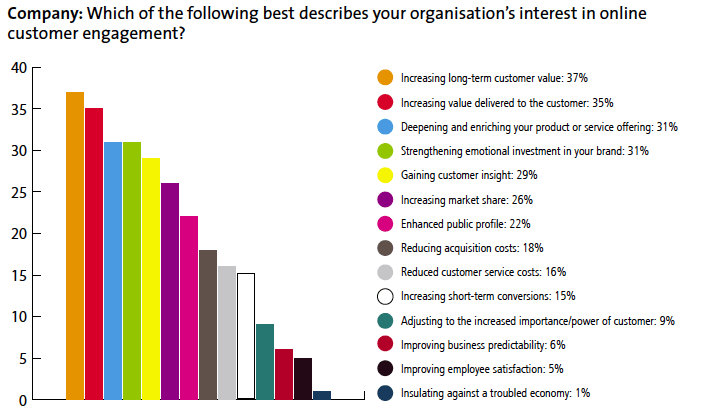It"€™s perhaps hard to imagine now, but even just four years ago, talk of customer engagement was a bit of a rarity. It is only a couple of years ago I did an interview with Dave where we discussed definitions and the scope of customer engagement.
There are many excellent reasons why businesses now focus on engagement. This year"€™s Annual Customer Engagement Report reveals some of the most important, for example "€˜increasing customer value"€™, "€˜gaining customer insights"€™, "€˜increasing value delivered to the customer"€™ etc as shown in the chart below:

However while any or all of these are excellent outcomes from engagement they are rarely the best place to start when developing a robust customer engagement strategy. For that we need to understand the four main challenges to engagement that have come to define customer relationships this millennium.
1. Our customers are increasingly distracted
We are currently living in the most information rich, attention demanding, message laden, multi-channel time that has ever existed. One recent study even indicated that the average length of uninterrupted time for a desk-based worker was just 2.7 minutes.
So the first major challenge any customer engagement strategy must take is cutting through this distraction to convey the value of our business "€“ not just once but again and again, because engagement is built on repeated interactions. [The definition of Customer Engagement we use is: "€˜Repeated interactions that strengthen the emotional, psychological and physical investment a customer has in a brand (product or company)"€™.]
Solution: The primary tactics to embrace to meet the challenge of customer distraction are simplicity and persuasion.
Simplicity is achieved by focusing our efforts on our customers"€™ scarcest resource. For one customer segment that might be time, for another it might be mental effort. People tend to find things simple that they do over and over again, if you can piggyback an already existing customer routine the chances are you more likely to engage them.
Based on an understanding of customer psychology, persuasion recognises that our customers navigate all the distractions they face by looking for short cuts to establish if something is valuable "€“ for example: If other customers are using using/buying a product it must be useful. Highlighting things that help our customers take these short cuts means a customer is less likely to pass over us and our product.
2. Our customers have increased expectations
If we can"€™t provide quality right now the likelihood is that our customers will find someone else, and fast. Switching products and suppliers has never been so easy for our customers. While the importance of post-sales support has also increased dramatically as the ability to amplify discontent is now just one click and a Facebook group away. So how are we to meet, and even exceed our customers"€™ expectations?
Solution: Expectations can be met by increasing the relevance of our product, service and communications. While time spent on gaining a deeper understanding of you audience doesn"€™t always pay dividends, using that understanding to develop a framework for personalisation does. Focus on establishing what the right-channel is, the right-timing and right-messaging for each customer segment as a first step.
3. Our customers are listening to new models of authority
Trust in old forms of authority: politicians, businesses, academics, scientists etc have continued to decline and in their place new models of authority have arisen. Encyclopaedias are replaced by Wikipedia, Bank Managers are replaced by MoneySavingExperts and Travel Agents are replaced by Trip Advisors. The common element in many of these new authorities is people supporting and trusting each other.
Any Customer Engagement strategy needs to understand and address this shift in trust relations if it is to have long-term value.
Solution: Become a new model of authority for your area of business. Provide free expert advice, this is often best done via someone else"€™s website rather than your own. Recognise that the only way you are able to establish authority today is through offering something valuable to your customers, while any interaction with them that doesn"€™t offer value undermines your authority.
4. Our customers are establishing new communities
With the new sources of authority come new ways of connecting. The challenge for those interested in Customer Engagement is how do we join the discussions within these communities without coming across as outsiders wishing to disrupt the conversation. The language of customer-to-customer exchange is often difficult to learn and even harder to articulate business needs through.
Solution: Again the key to participating in the new communities is to add value. While supporting or hosting a customer community can be an excellent way of establishing a community the best way to engage community participants is usually to open channels back into your business. Providing access to the product developers or the company decision-makers that can offer insights into how and why things work the way they do and is often deeply engaging for customers.
While the tactics used for engagement will vary over time and audience these four challenges are universal and any customer engagement strategy that starts from the perspective of addressing them will have an excellent chance of long-term success.







